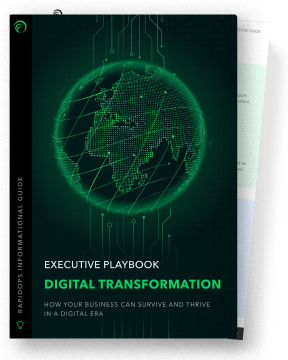- Transformation
- February 2022
What Is Digital Transformation Framework and Why Is It Important for Businesses?
In our previous blog under the digital transformation series, we covered the benefits of digital transformation. This article will cover the steps involved in creating a proper digital transformation framework for any organization.
We will also cover many other aspects of the digital transformation framework. With the pace at which digital technologies are being inducted into processes and systems, businesses are forced to take hasty steps to digitize their working environment.
Read our ultimate guide on digital transformation: Digital Transformation Guide: An In-Depth Review for Undertaking Organizational Digitization Initiative
If significant steps are not taken, businesses might lose to their competition or risk falling behind in capturing the market.
What is a digital transformation framework?
Digital disruption takes much toll on businesses that heavily rely on legacy systems. When such companies look at the evolving business conditions and observe the technologies being included to modernize the business process, they often get overwhelmed.
A digital transformation framework acts as their blueprint and allows them to create a common reference point that can be used across an organization. It also acts as a tool in successfully creating their digital transformation strategy.
Apart from not having a strategy, the lack of aligning KPIs with the digital transformation goals is also a significant roadblock to achieving digital maturity for businesses. Because of this, they require a plan for how and when to make crucial strategic upgrades to their core systems and processes.
So, you can say that a digital transformation framework is a structured guide that organizations can use for taking control of their transition, rather than getting overwhelmed by the change.
What is digital transformation?
According to McKinsey, 20% to 50% economic gains and 20% to 30% increase in client satisfaction can be achieved with the help of digital transformation.
Digital transformation of businesses traditionally requires the adoption of cutting-edge technology to keep up with the changing requirements of customers and the market trends. However, it is not just about technology.
Before taking digital transformation initiatives, business leaders must keep tabs on the budget, time, people, and other required resources.
Why do organizations need a digital transformation framework?
70 percent of large-scale transformation programs fail – McKinsey
Such a staggering number is enough to dishearten businesses that want motivation to create their digital transformation roadmap. Here are the common roadblocks to a successful implementation of digital transformation.
Some of the most common pitfalls of digital transformation initiatives are:
- Resistance to changing culture
- Lack of proper leadership
- Poor cross-functional collaboration
Having a digital transformation framework guides organizations around the pitfalls by creating business-wide roadmaps that employees and executives can refer to for staying on the path to achieving the goal of organizational transformation.
Although there are many digital transformation frameworks formulated for reference, here are some common patterns generally found:
- Digitizing the business model
- Automating the processes
- Enhancing digital talent
- A customer-centric approach to products and services development
- Bringing innovative thought-process to work culture
- Enhancing collaborative leadership
So, creating a digital transformation strategy becomes crucial for businesses. They must base this on customer value proposition enhancement and the newly digitized operations.
Common digital transformation models
Let's see the most common modern digital transformation model used around the globe.
1. McKinsey 7S framework

The McKinsey 7S Framework is a management model developed by business consultants Robert H. Waterman, Jr. and Tom Peters in the 1980s. This was a strategic vision for groups, including businesses, business units, and teams. The 7S's are structure, strategy, systems, skills, style, staff, and shared values.
2. The ADKAR states of change

The ADKAR states of change enable leaders to understand organizational change as a process by breaking it down into three stages.
a.) The current state
The current stage defines where the business is and how are the operations, departments, people, tools, and processes being managed at present?
b.) The transition
In the transition phase, things tend to get disorganized as the workforce has to understand and learn new ways of carrying out their daily tasks. The transition phase is the toughest as it involves various emotions related to individuals.
c.) The future
The future is where the organization wants to reach. As the transition is still occurring, this phase might not be well-defined; however, it helps businesses understand what they must do better than their current state in terms of performance.
Rapidops' digital transformation framework

With 13+ years in consulting and developing meticulous digital products that solve business problems, we are sharing a generalized transformation framework for those who want to bring digital disruption to their organization.
This framework is a blueprint for business leaders or those tasked to create a sound digital transformation strategy for their organization. So, let's take a look into it.
Steps involved in developing a digital transformation framework
Since you have decided to create your digital transformation framework, let's go and cover additional steps in building it.
Step 1. Identifying the organizational digital transformation objectives
The main objective of any corporate digital transformation project is to improve customer experience and business profitability. This can be achieved by enhancing their cost-to-profit ratio or enhancing operational efficiency.
Try to identify the digital transformation objectives on the basis of the organization's size, market share, workforce, etc. Let’s create some company use cases to understand objectives further.
a.) Digitizing the offerings
According to studies, two-thirds of a company's competitive edge comes from its customer experience. This means that providing state-of-the-art offerings will help them gain a competitive advantage in the increasingly moving digitalization market.
This is important for B2C businesses within retail, insurance, and banking industries that need a customer-centric approach where the end-users value pricing and customer experience.
b.) Improving the processes
Redundant processes are found in every business's unproductive legacy operations. With the help of digital transformation initiatives, companies can enhance their processes with digital tools as they improve faster internal collaboration, increase automation rate, and enhance the production output.
c.) Designing adjacent business models
Technological advances enable businesses to monetize their present products & services. This also presents companies with opportunities to create more revenue channels by entering adjacent markets like what Amazon did with its on-demand cloud computing and OTT platform services.
Step 2. Choosing the right technology stack
Decide the technologies that will assist you in achieving your digital transformation objectives.
Note: The process of technology selection depends on the business use case.
We are listing some of the trending technologies businesses can include in their digital transformation stack:
- RPA
- Digital twins
- IoT
- Smart contracts
- Process mining
- Task mining
- Analytics
- Predictive maintenance
Tools that can assist business’s process transformation:
- Customer intelligence
- Personalization engine
- Recommendation engine
- Omnichannel communication
- Chatbots
Step 3. Formulating the digital transformation strategy
Once businesses gain clarity of their digital transformation objectives, they need to create a roadmap for achieving them. Organizational digital transformation projects must aim for an end-to-end makeover, and here a business's digital maturity helps decide the next step in the transformational journey.
Step 4. Establish a competent technology leadership
87% of businesses believe that digital will disrupt their industry, yet they don't have exemplary leadership. Digital transformation success depends on leadership and technological capabilities.
With streamlined and well-managed transformational leadership, the integration of digital culture becomes exceptionally smooth. This is how you can establish a competent digital transformation leadership:
- Prioritize agility and continuous improvement mindset
- Focus on change management
- Learn from the success or failure of MVP and apply it to your next project
- Improve on design-thinking approach
Step 5. Train the workforce to integrate a growing digital culture
Take risks, fail fast, but learn from them. That's what leaders must talk about with their workforce. A digital culture must promote a work environment where employees can easily communicate about innovation and are constantly asked to be more collaborative, continuously train and involve themselves to become an efficient workforce.
What are the benefits of a digital transformation framework for an organization?
As explained earlier, a digital transformation framework helps organizations avoid common roadblocks to their transformation success. Businesses get an organization-wide approach so that employees and executives stay on the exact path of achieving organizational goals. They need the digital transformation framework to:
- Build a digitized business model
- Have more customer-centric products and services
- Create an innovative culture
- Enhance enterprise-wide talent for digital technologies
- Encourage co-operative leadership
Digital transformation is a cumulative effort and requires all the departments, processes, and people to achieve the common goal. The digital transformation framework binds the organizational efforts and provides a starting point for digitalization.
Concluding thoughts: Consultation helps before developing a digital transformation framework
The digital transformation market is proliferating and is expected to reach USD 3.3 Billion by 2025 – Research and Markets
The purpose of organizations taking up digital transformation initiatives depends on
- what progress they want towards the end-state,
- what changes will be needed to go in that direction, and
- how efficiently the end goal will be achieved.
Digital transformation solution companies formulate digital strategies, implement technologies, and build digital tools to support digitalization. An established digital transformation partner with other supporting digital services can contribute to faster organizational profitability and scalability.
If you need to discuss the development of your digital transformation framework and understand the minor elements that contribute to its success, do get in touch with us.
What’s Inside
- What is a digital transformation framework?
- What is digital transformation?
- Why do organizations need a digital transformation framework?
- Common digital transformation models
- Rapidops' digital transformation framework
- What are the benefits of a digital transformation framework for an organization?
- Concluding thoughts: Consultation helps before developing a digital transformation framework





